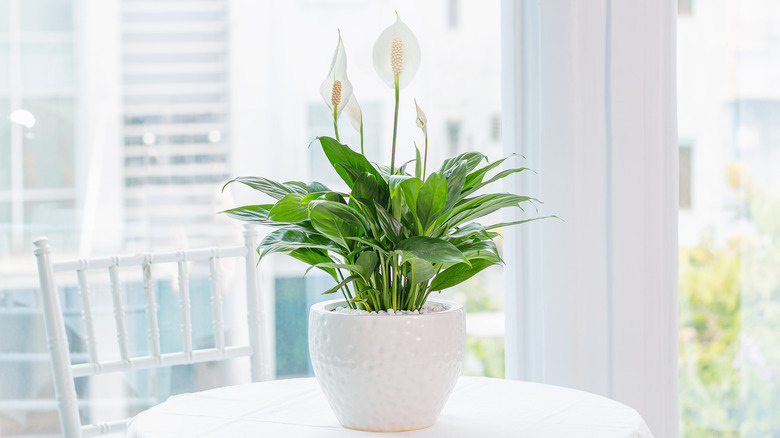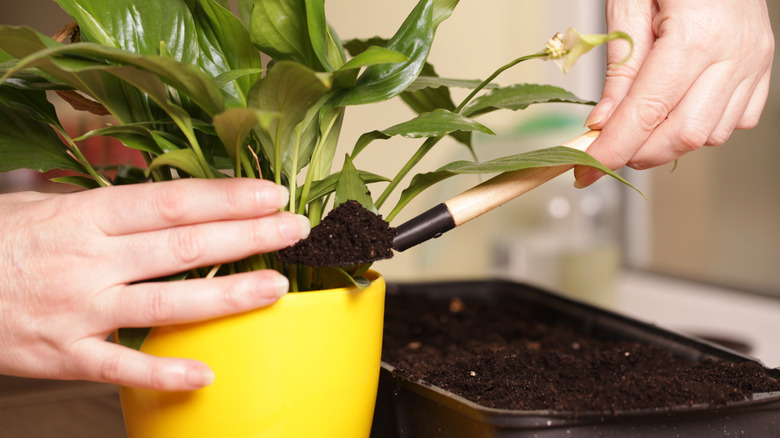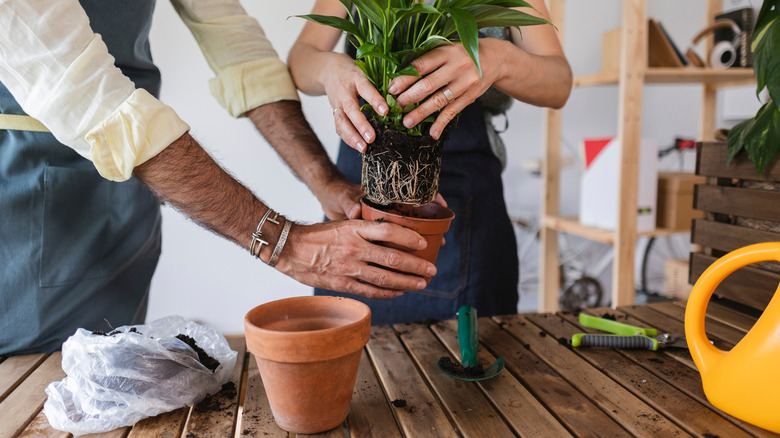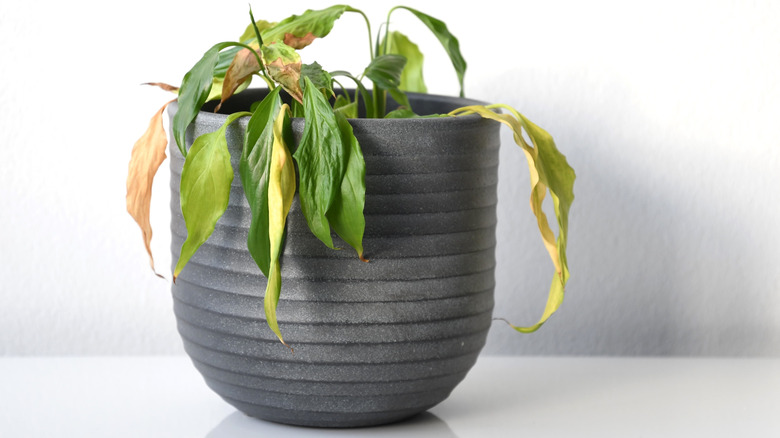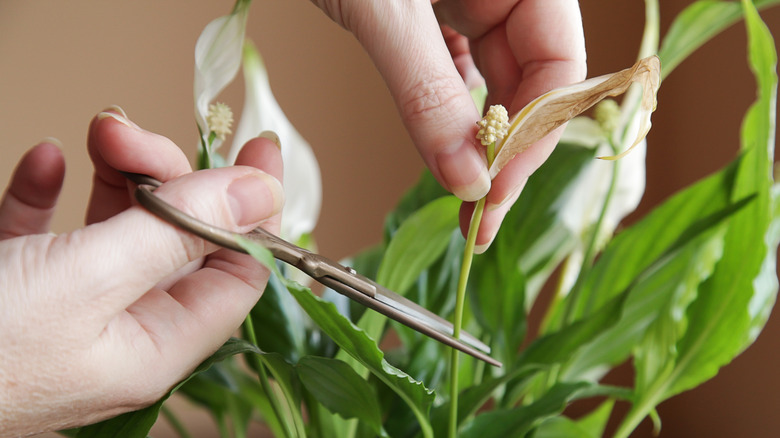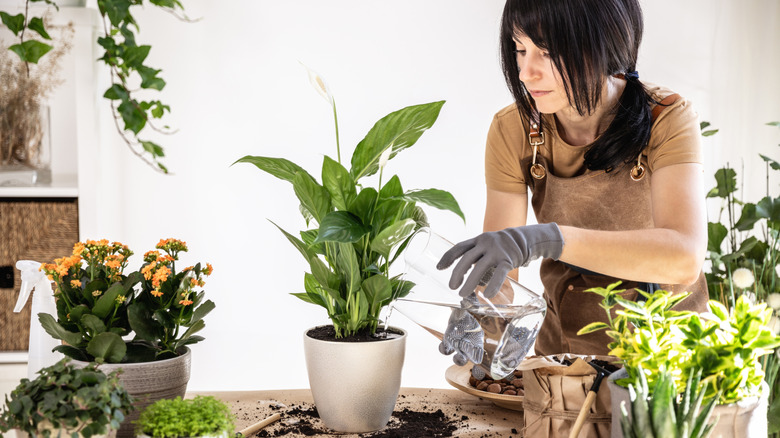Tips And Tricks To Help Your Peace Lilies Thrive
If a peace lily has found its way into your life, there's a good chance it made the journey in a pot and that it continues to live in one. Peace lilies (Spathiphyllum spp.) are hardy in USDA zones 11 and 12, and can't withstand sustained temperatures below 40 degrees. So, for most of us, they end up living alongside our families indoors, in a pot, and at our mercy. Because we take on the responsibility of growing them in conditions we're completely in control of, helping a peace lily thrive can be a challenge.
To get to the bottom of how to keep peace lilies happy and prosperous, Hunker spoke exclusively with Lisa Eldred Steinkopf, expert at The Houseplant Guru and author of "Houseplants: The Complete Guide to Choosing, Growing, and Caring for Indoor Plants" and "Grow in the Dark: How to Choose and Care for Low-Light Houseplants." She ran down the peculiarities of peace lilies for us, and laid out a plan for caring for them that gives these popular houseplants their best chance to thrive — including ideal potting containers, proper soil conditions, correct watering frequency, and problems to look out for. This way, your peace lily can live as long as possible.
Soil, structure, and the art of potting
In Hunker's exclusive interview with Lisa Eldred Steinkopf, rather than talking about peace lilies as fragile and difficult plants, she emphasized how moderation in most aspects of their care is the right approach. Its peculiarities, after all, aren't really that peculiar. How many plant species likes moist, well-drained soil? It's probably true more often than not, and it's true of peace lilies as well. But, of course, moist never means wet. "Peace lilies like to be kept moist at all times, but they don't want to stand in water," she said.
We'll come back to watering itself, but the potting medium and the pot you choose plays a big role in how well you can manage the amount of water in the soil. "I would use a high-quality, well-drained potting mix," Steinkopf explained. "I often add a bit of perlite or orchid bark to a quality potting mix to help the drainage capabilities. I don't use potting mix with added fertilizer or moisture control." In fact, keeping things simple gives you the best chance to keep a peace lily happy.
For Steinkopf, this means eschewing the use of drainage materials like gravel, pebbles, and pot shards, which can actually inhibit drainage and reduce the usable space available for roots to grow above any too-wet perched water table within the pot. Steer clear of pots without drainage holes, except as cachepots with another pot inside them. You can add drainage holes with a diamond-tipped drill bit. If you need help keeping the soil in your pot, place window screen material above the drainage holes, which should do the trick.
Potting a peace lily up (or down)
Of course, the size of the pot matters. Some experts say that the peace lily, like bougainvillea, is happiest when root-bound. But when Hunker spoke exclusively with houseplant expert Lisa Eldred Steinkopf, she emphasized giving peace lilies just enough room. "If the plant needs water more often than usual, it may be root-bound," she said. "If the roots are coming out of the hole of the container, it needs to be potted up into the next size container." But she prefers to up-pot in small steps, only increasing the pot's size by the smallest amount each time, since an overly large pot can result in root ball rot.
Of course, it also matters when and how you do your up-potting. "I like to do that in the spring or as soon as the plant shows new growth in late winter/spring," Steinkopf said. Only pot up a peace lily in the fall if it is root-bound. Another option for a peace lily with multiple crowns (separate bunches of leaves that can grow independently after a rhizome division) is to split the plant into separate pots, rather than simply potting up. And, if your pot-bound peace lily is showing aerial roots, you have the option of burying its stems deeper in its new pot, covering the developing roots with potting soil to encourage their development.
Watering your peace lily
Conversations about peace lilies often come around again and again to the topic of watering, in part because this houseplant is sometimes seen as a bit finicky about its drinking preferences. But it's easy to get the impression that peace lilies are overly demanding. Sure, they like just enough water (who doesn't?), and they prefer water that's as chemical-free as possible (again, who doesn't?). But knowing when to water isn't necessarily difficult.
"The best way to avoid incorrect watering is to check your plant often for its watering needs," Steinkopf said when Hunker spoke with her exclusively about how to help peace lilies thrive. "If the top few inches of your plant are dry, it's time to give it a drink." She cautions against the "let it droop" method of letting the plant wilt between waterings, as it could result in a peace lily with curling, yellow leaves.
How much water? Steinkopf explains, "When you water a plant, make sure you thoroughly water it so that the water runs out of the drainage hole." While some let peace lily pots sit in a saucer or tray of water, she prefers to let drainage itself guide the way. "Let it drain and empty the saucer of any excess water after ½ hour or so," she said. "Don't let it stand in water." As for which water to use, you'll occasionally see experts claim that peace lilies are so sensitive to chemicals in water that they require distilled water, but it's usually sufficient to use collected rainwater or to let tap water sit for a day or so to remove most of the chlorine.
Common problems you may encounter
Peace lilies are actually fairly resilient if you pay attention to potting and watering in a common-sense way. The handful of common problems these plants experience are simple enough to deal with or even prevent. When Hunker spoke exclusively with Lisa Eldred Steinkopf, she emphasized normal houseplant care. "The most common problem I see is that people don't realize how often their plants need water," she said. "The plant dries out, collapses, and pops back up after watering," she said. "There are always consequences if a plant is not well taken care of. If a plant dries out and bounces back when watered, it may (and probably will) develop yellowing leaves. These need to be cut off."
While the peace lily is somewhat pest-resistant, it can be susceptible to mealybugs and scale. "These are insects that suck the juices from your plant," Steinkopf explained. "The first thing to do is wipe them off. Then use insecticidal soap, neem, a biological control, or systemic insecticide to treat the pests." Peace lilies can also acquire a white, powdery fungus on occasion as a result of not having much exposure to direct sunlight.
General care tips for peace lilies
So, you've kept your peace lily warm in a pot with enough room and enough water. How else can you help it thrive? It's important to do normal maintenance like removing yellowing leaves, as Lisa Eldred Steinkopf mentioned when Hunker spoke with her exclusively, as well as removing the brown material left naturally by dead stems from previous growth.
You will also need to feed any plant isolated in a pot, of course, and peace lilies are sensitive to over-fertilizing. Steinkopf prefers a balanced fertilizer like a 20-20-20. "I would fertilize every fourth watering, so approximately once a month," she said. "You can also fertilize your plant every time you water it with ¼ strength fertilizer." Fertilize a re-potted peace lily in the spring.
The seasons also have a minor impact on your watering schedule, as well. "The plant may need more water when the heater is turned on in the fall, though there is less light outside as the days grow shorter," Steinkopf said. "Again, the key is checking your plant often."
